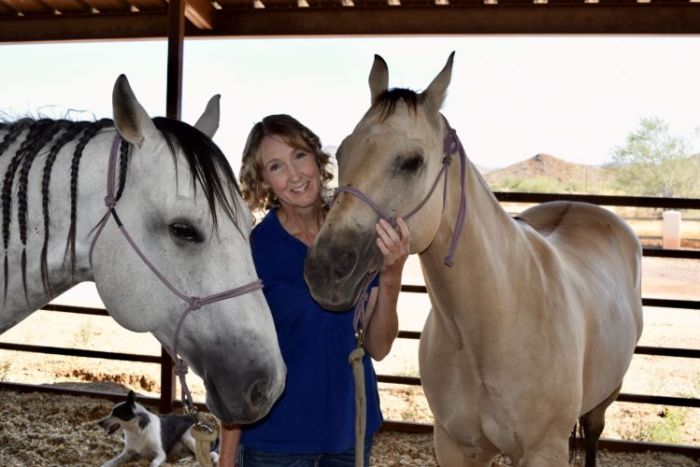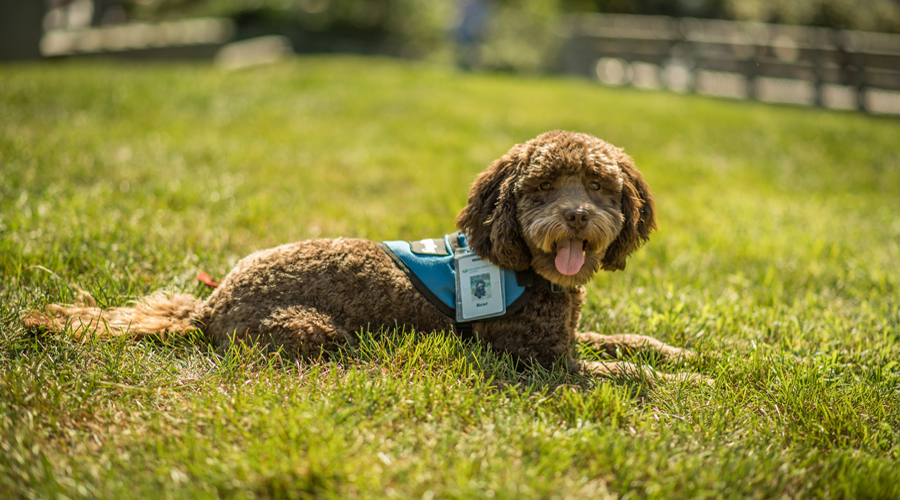Learn / Can Animal-Assisted Therapy Actually Help You Heal?
Can Animal-Assisted Therapy Actually Help You Heal?


October 14th, 2022| Clinically Reviewed by
Some people find it easier to relate to animals than to other humans.
Animals are easy to be around, as they’re nonjudgmental and unconditionally loving. And those can be especially helpful qualities when you’re working through vulnerable issues.
In animal-assisted therapy (AAT), animals like horses, dogs, and dolphins support the therapy process by helping people feel safe to explore feelings they might otherwise struggle to get in touch with.
The Basics of AAT
All animal-assisted therapies share the following qualities:
- They’re goal-directed.
- They aim to improve physical, social, emotional, or cognitive function.
- The animal is a central part of treatment.
- A licensed service provider facilitates the interaction.
AAT can take place in group or individual settings. It’s important to note that animal-assisted therapies are an addition to primary care.1 In rehab, you’ll likely work through a treatment plan based on psychotherapy, with AAT and other complementary therapies supporting your experience.
Some facilities even allow you to bring your pet to rehab.
Which Animals Does Animal-Assisted Therapy Use?
Therapists may bring various animals into an AAT session:
- dogs
- cats
- horses
- farm animals
- birds
- dolphins
- reptiles
Some animals are more popular in treatment programs because their personality traits lend themselves to therapeutic goals. While you may be more likely to encounter horses, dogs, and dolphins, which animals your rehab works with will depend on their location, facilities, and staff.
When choosing an AAT program, consider which animals you feel a stronger connection with. For example, you might resonate more with dogs if your beloved childhood pet was a golden retriever. “Some people just have preferences for other animals2 and it triggers some memories for them that were positive,” said Rachel Boulden, a treatment administrator at Baylor Women’s Correctional Institution.
Equine Therapy: “Horses Don’t Judge”
In equine therapy (ET), therapists use horses to facilitate connection, comfort, and healing.3 Sessions usually involve tasks like grooming, riding, or walking the horse. Your therapist will assess your comfort level with horses before asking you to do any activities—in fact, the first session often involves simply getting to know the horse.
This nonjudgmental space helps people feel more at ease expressing their emotions. According to Janice Story, an Equine and Meditation Coach at Soberman’s Estate, “The horses are incredible at helping our clients feel connected because horses don’t judge. Our clients immediately feel a connection with them. It helps teach them trust. It teaches them communication and boundaries.”

In addition to working on communication, equine therapy can also help with confidence. Horses are large animals, which might feel intimidating for some. Many patients find that overcoming these fears raises their self-esteem.
Canine Therapy: “You Could Feel All That High-Stress Energy Had Just Dissipated”
Canine-assisted therapy, also known as dog-assisted therapy, is the most popular form of AAT. During sessions, people can interact with the dog—they might pet them, talk to them, or simply sit with them.
“You could feel all that high-stress energy had just dissipated and you see the person petting the dog and having a conversation with the handler,”4 says sociology professor Dr. Colleen Anne Dell. “Sometimes they’re having conversations. Sometimes they’re not. Sometimes the dog is just snuggling up to them and they’re getting that comfort from that animal.”
Dolphin Therapy: “They Connect With You Somehow”
Dolphin-assisted therapy sessions5 start with simple interactions, like touching or giving commands to the animals. You might care for the dolphin, or simply observe it. After you feel more comfortable, you may complete various exercises that involve swimming or playing with the dolphins.
The length and duration of sessions vary from program to program. Dolphins are usually captive, though some facilities use wild dolphins. At Hawaii Island Recovery, clients can swim with wild spinner dolphins.
Environmentally conscious treatment seekers should note that this therapy is controversial. While many purport its benefits, others say there’s no science to support it.6 Claims that captivity causes dolphins psychological harm7 are widely known, but the National Oceanic and Atmospheric Administration also advises against dolphin interactions in the wild.8 A new law in Hawaii even “prohibits swimming with, approaching, or remaining within 50 yards (45.7 meters) of a Hawaiian spinner dolphin.”
The Benefits of Animal-Assisted Therapy: Healing Through Unconditional Love
1. Animals Have Calming Effects
Spending time with animals can decrease stress, even if it’s only for a short while. One study found that interacting with therapy dogs for just 5 minutes decreased stress and anxiety9 in emergency workers.
This might be because connecting with animals lowers levels of cortisol:10 the hormone associated with stress. Research also shows that interactions with dogs increase oxytocin levels,11 especially when the dog is your pet. Known as the “love hormone,” oxytocin encourages relaxation and eases stress.

“Oxytocin has some powerful effects for us in the body’s ability to be in a state of readiness to heal, and also to grow new cells,”12 says Rebecca Johnson of the Research Center for Human/Animal Interaction at the University of Missouri College of Veterinary Medicine, “so it predisposes us to an environment in our own bodies where we can be healthier.”
2. A Safe Space to Explore Emotions
Animals aren’t judgmental beings, which is a large part of why AAT allows people to open up. Some people still feel uncomfortable sharing their deepest emotions with a fellow human, even if that human is a trained psychotherapist. But they may feel more at ease with an animal.
“They’ll sit on the ground holding the dog and say, ‘I hate talking about this’ or ‘I don’t want to admit this,’ but they’ll start talking to the dog and start sharing, and it all just comes out,” says Boulden.
3. Animals Understand You
Animals seem to understand how humans feel. Dogs in particular have more therapeutic impact13 than other animals. This could be because of their “emotional evolution:” a result of the domestication process.
Researchers of dog-human relationships 14 explain:
“Through the processes of domestication and natural selection, dogs have become adept at socializing with humans. For example, research suggests dogs are sensitive to our emotional states as well as our social gestures, and they also can communicate with us using complex cues such as gaze alternation. In addition, dogs can form complex attachment relationships with humans that mirror that of infant-caregiver relationships.”
4. Animals Reduce Loneliness and Provide Social Support
Addiction is often called a disease of isolation,15 and loneliness plays a major role in substance abuse. Even when substances aren’t in the picture, social isolation can significantly impact our mental health. Former Surgeon General Vivek Murthy noticed this when he spoke with people across different communities. Those who struggled with mental health issues like depression, addiction, and anxiety seemed to have one commonality: feeling alone.
Luckily, pets can help with that.16
Animals provide unconditional acceptance10 and love, which alleviates lonely feelings. And in addition to their own companionship, animals can facilitate more social interactions with other people. “Animals can become a way of building a bridge for those social interactions,” says Dr. James Griffin, a child development expert at National Institutes of Health.
Potential Drawbacks of Animal-Assisted Therapy
1. Safety Concerns
For the most part, animal-assisted therapies are safe. Certified animals undergo rigorous training to prevent sticky situations from occurring.
But some animals are more tame than others. The risks involved in interacting with dogs or cats, for example, are far less than with horses or dolphins. “Because dolphins aren’t domesticated,6 they don’t lose their wild traits, and their behavior is difficult to predict or control,” says Toni Frohoff, a behavioral and wildlife biologist for Terramar Research.
2. AAT Can Be Expensive
For the most part, AAT isn’t cheap, especially if you travel to a new location. For example, 5 days of dolphin therapy in the Bahamas is $4,500—not including airfare or accommodation.6
3. Results Are Mixed
While research shows that it improves mental health, experts note that many of the studies on AAT are flawed.17 Common issues include lack of follow-up studies, small numbers of participants, and possible bias from researchers. It’s also difficult to measure outcomes of AAT. A patient could feel happier as a result of environmental factors like traveling somewhere new, for example, or spending time outdoors while horseback riding.
4. Not Everyone Finds Animals Comforting
If you’ve had a traumatic experience with an animal in the past, involving them in therapy during a vulnerable time might be triggering. AAT might be more trouble than it’s worth if you dislike or are allergic to animals.
Could Furry Friends Help Your Recovery?
If you already feel comfortable with animals, animal-assisted therapy could be a great complement to your primary treatment plan. Animals help us relax, connect, and feel better about ourselves—which we can all use more of, especially in trying times.
Explore rehab centers that offer animal-assisted therapy to find out about their program highlights, facilities, accepted insurance, and more.
Reviewed by Rajnandini Rathod
- Monfort Montolio, M., & Sancho-Pelluz, J. (2020). Animal-assisted therapy in the residential treatment of dual pathology. International Journal of Environmental Research and Public Health, 17(1), 120. https://doi.org/10.3390/ijerph17010120 [↩]
- Sawicki, R. (2022, March 5). Animal-Assisted Therapy Brings Joy to a Delaware Prison. U.S. News & World Report; U.S. News & World Report L.P. https://www.usnews.com/news/best-states/delaware/articles/2022-03-05/animal-assisted-therapy-brings-joy-to-a-delaware-prison [↩]
- Marchand, W. R., Andersen, S. J., Smith, J. E., Hoopes, K. H., & Carlson, J. K. (2021). Equine-assisted activities and therapies for veterans with posttraumatic stress disorder: Current state, challenges and future directions. Chronic Stress, 5, 2470547021991556. https://doi.org/10.1177/2470547021991556 [↩]
- Pooch Power: Therapy Dogs Bring Quick Relief in the ER. (2022, March 10). U.S. News & World Report; U.S. News & World Report L.P. https://www.usnews.com/news/health-news/articles/2022-03-10/pooch-power-therapy-dogs-bring-quick-relief-in-the-er [↩]
- Fiksdal, B. L., Houlihan, D., & Barnes, A. C. (2012). Dolphin-assisted therapy: Claims versus evidence. Autism Research and Treatment, 2012, 839792. https://doi.org/10.1155/2012/839792 [↩]
- Inside the murky world of dolphin therapy. (2021, August 11). Animals. https://www.nationalgeographic.com/animals/article/inside-the-murky-world-of-dolphin-therapy [↩] [↩] [↩]
- MacDonald, James. “The Ethics of Research on Captive Dolphins.” JSTOR Daily, 7 Oct. 2019, https://daily.jstor.org/the-ethics-of-research-on-captive-dolphins/. [↩]
- Fisheries, NOAA. “Six Reasons Why You Should Not Swim with Wild Spinner Dolphins | NOAA Fisheries.” NOAA, 12 Nov. 2021, https://www.fisheries.noaa.gov/feature-story/six-reasons-why-you-should-not-swim-wild-spinner-dolphins. [↩]
- Kline, Jeffrey A., et al. “Randomized Trial of Therapy Dogs Versus Deliberative Coloring (Art Therapy) to Reduce Stress in Emergency Medicine Providers.” Academic Emergency Medicine, edited by Mark B. Mycyk, vol. 27, no. 4, Apr. 2020, pp. 266–75. DOI.org (Crossref), https://doi.org/10.1111/acem.13939. [↩]
- The power of pets. (2018, February 1). NIH News in Health. https://newsinhealth.nih.gov/2018/02/power-pets [↩] [↩]
- Cimons, Marlene. “Your Dog Can Make You Feel Better, and Here’s Why.” Washington Post, 19 Sept. 2016. www.washingtonpost.com, https://www.washingtonpost.com/national/health-science/your-dog-can-make-you-feel-better-and-heres-why/2016/09/19/fde4aeec-6a2a-11e6-8225-fbb8a6fc65bc_story.html. [↩]
- Rovner, Julie. “Pet Therapy: How Animals And Humans Heal Each Other.” NPR, 5 Mar. 2012. NPR, https://www.npr.org/sections/health-shots/2012/03/09/146583986/pet-therapy-how-animals-and-humans-heal-each-other. [↩]
- Bolt, Charlotte, et al. “Exploring the Therapeutic Opportunities, Challenges and Psychological Mechanisms of Integrating Dogs into Psychological Therapies with Adults.” Complementary Therapies in Clinical Practice, vol. 47, May 2022, p. 101564. ScienceDirect, https://doi.org/10.1016/j.ctcp.2022.101564. [↩]
- Gee, Nancy R., et al. “Dogs Supporting Human Health and Well-Being: A Biopsychosocial Approach.” Frontiers in Veterinary Science, vol. 8, Mar. 2021, p. 630465. PubMed Central, https://doi.org/10.3389/fvets.2021.630465. [↩]
- Everything You Think You Know about Addiction Is Wrong | Johann Hari. www.youtube.com, https://www.youtube.com/watch?v=PY9DcIMGxMs. Accessed 29 Sept. 2022. [↩]
- Lee, Bruce Y. “Are You Feeling Lonely? How About Getting A Pet?” Forbes, https://www.forbes.com/sites/brucelee/2019/06/02/are-you-feeling-lonely-how-about-getting-a-pet/. Accessed 29 Sept. 2022. [↩]
- Kamioka, H., Okada, S., Tsutani, K., Park, H., Okuizumi, H., Handa, S., Oshio, T., Park, S.-J., Kitayuguchi, J., Abe, T., Honda, T., & Mutoh, Y. (2014). Effectiveness of animal-assisted therapy: A systematic review of randomized controlled trials. Complementary Therapies in Medicine, 22(2), 371–390. https://doi.org/10.1016/j.ctim.2013.12.016 [↩]
Return to Resource Library
Our Promise
How Is RehabPath Different?
We believe everyone deserves access to accurate, unbiased information about mental health and addiction. That’s why we have a comprehensive set of treatment providers and don't charge for inclusion. Any center that meets our criteria can list for free. We do not and have never accepted fees for referring someone to a particular center. Providers who advertise with us must be verified by our Research Team and we clearly mark their status as advertisers.








